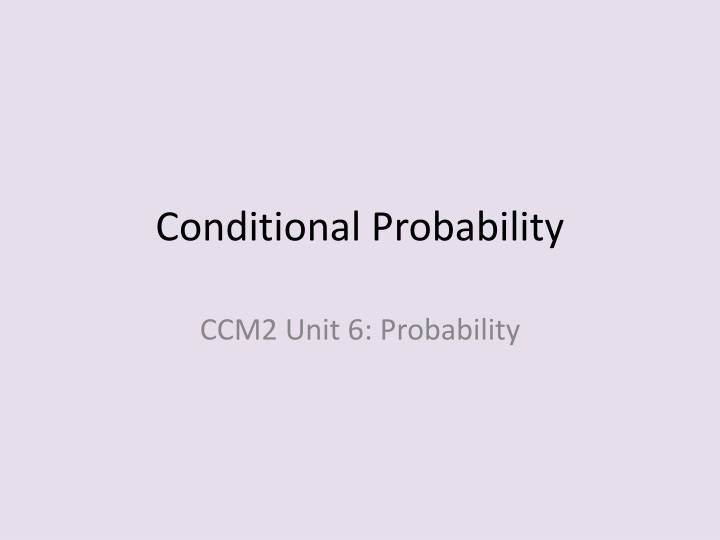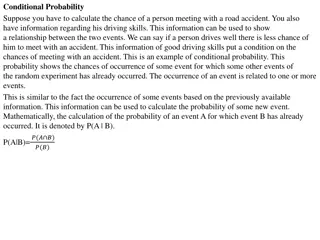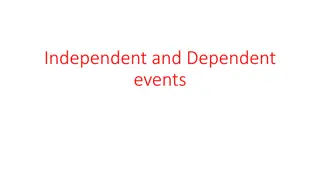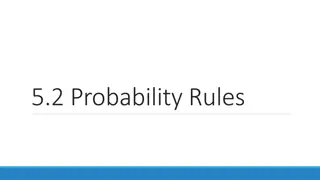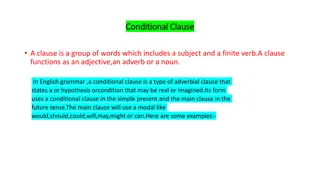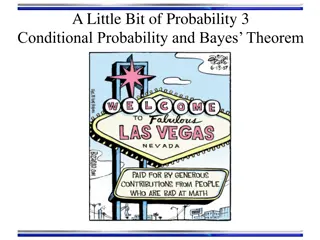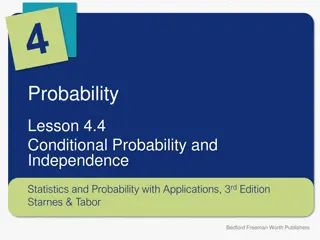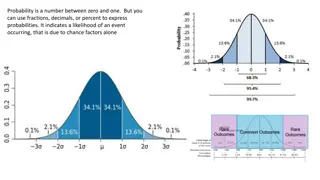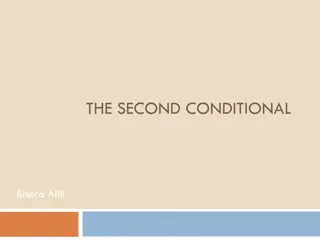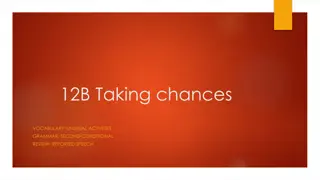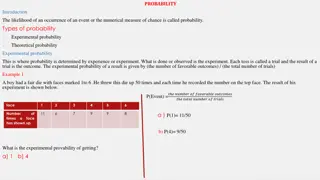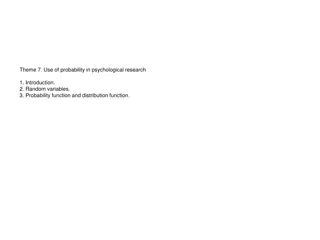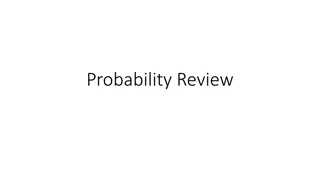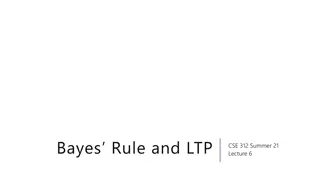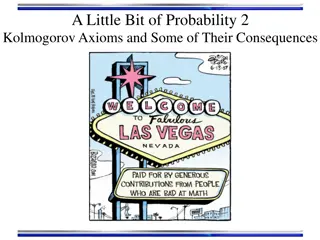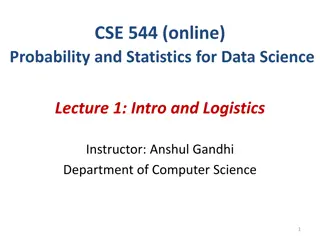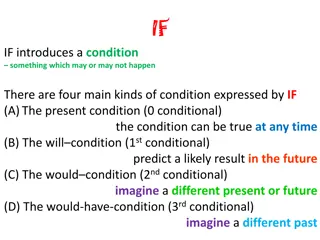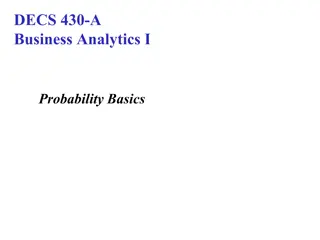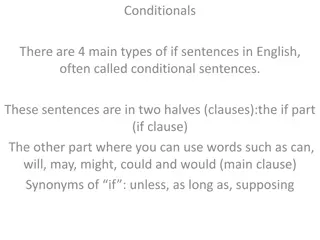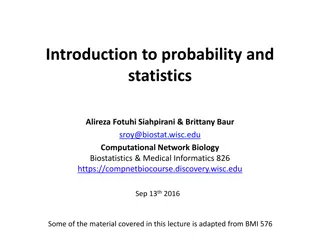Conditional Probability
Conditional probability is a key concept in probability theory where the likelihood of an event is determined given that a certain condition has already occurred. This involves expressing the probability of one event happening given that another has already taken place. Explore examples and the notation used to calculate conditional probabilities, along with the use of two-way frequency tables in computing them.
Download Presentation

Please find below an Image/Link to download the presentation.
The content on the website is provided AS IS for your information and personal use only. It may not be sold, licensed, or shared on other websites without obtaining consent from the author.If you encounter any issues during the download, it is possible that the publisher has removed the file from their server.
You are allowed to download the files provided on this website for personal or commercial use, subject to the condition that they are used lawfully. All files are the property of their respective owners.
The content on the website is provided AS IS for your information and personal use only. It may not be sold, licensed, or shared on other websites without obtaining consent from the author.
E N D
Presentation Transcript
Conditional Probability CCM2 Unit 6: Probability
Conditional Probability Conditional Probability: A probability where a certain prerequisite condition has already been met. Conditional Probability Notation The probability of Event A, given that Event B has already occurred, is expressed as P(A | B).
Examples 1. You are playing a game of cards where the winner is determined by drawing two cards of the same suit. What is the probability of drawing clubs on the second draw if the first card drawn is a club? P(club club) = P(2ndclub and 1stclub)/P(1stclub) = (13/52 x 12/51)/(13/52) = 12/51 or 4/17 The probability of drawing a club on the second draw given the first card is a club is 4/17 or .235
2. A bag contains 6 blue marbles and 2 brown marbles. One marble is randomly drawn and discarded. Then a second marble is drawn. Find the probability that the second marble is brown given that the first marble drawn was blue. P(brown blue) = P(brown and blue)/P(blue) = (6/8 x 2/7)/(6/8) = 2/7 The probability of drawing a brown marble given the first marble was blue is 2/7 or .286
3. In Mr. Jonas' homeroom, 70% of the students have brown hair, 25% have brown eyes, and 5% have both brown hair and brown eyes. A student is excused early to go to a doctor's appointment. If the student has brown hair, what is the probability that the student also has brown eyes? P(brown eyes brown hair) = P(brown eyes and brown hair)/P(brown hair) = .05/.7 = .071 The probability of a student having brown eyes given he or she has brown hair is .071
Using Two-Way Frequency Tables to Compute Conditional Probabilities In CCM1 you learned how to put data in a two-way frequency table (using counts) or a two-way relative frequency table (using percents), and use the tables to find joint and marginal frequencies and conditional probabilities. Let s look at some examples to review this.
1. Suppose we survey all the students at school and ask them how they get to school and also what grade they are in. The chart below gives the results. Complete the two-way frequency table: Bus Walk Car Other Total 9thor 10th 106 30 70 4 11thor 12th 41 58 184 7 Total
Bus Walk Car Other Total 9thor 10th 106 30 70 4 210 11thor 12th 41 58 184 7 290 Total 147 88 254 11 500 Suppose we randomly select one student. a. What is the probability that the student walked to school? 88/500 .176 b. P(9thor 10thgrader) 210/500 .42 c. P(rode the bus OR 11thor 12thgrader) 147/500 + 290/500 41/500 396/500 or .792
Bus Walk Car Other Total 9thor 10th 106 30 70 4 210 11thor 12th 41 58 184 7 290 Total 147 88 254 11 500 d. What is the probability that a student is in 11th or 12th grade given that they rode in a car to school? P(11thor 12th car) * We only want to look at the car column for this probability! = 11thor 12thgraders in cars/total in cars = 184/254 or .724 The probability that a person is in 11thor 12thgrade given that they rode in a car is .724
Bus Walk Car Other Total 9thor 10th 106 30 70 4 210 11thor 12th 41 58 184 7 290 Total 147 88 254 11 500 e. What is P(Walk|9th or 10th grade)? = walkers who are 9thor 10th/ all 9thor 10th = 30/210 = 1/7 or .142 The probability that a person walks to school given he or she is in 9thor 10thgrade is .142
2. The manager of an ice cream shop is curious as to which customers are buying certain flavors of ice cream. He decides to track whether the customer is an adult or a child and whether they order vanilla ice cream or chocolate ice cream. He finds that of his 224 customers in one week that 146 ordered chocolate. He also finds that 52 of his 93 adult customers ordered vanilla. Build a two-way frequency table that tracks the type of customer and type of ice cream. Vanilla Chocolate Total Adult Child Total
Vanilla Chocolate Total Adult 52 93 Child Total 146 224 Vanilla Chocolate Total Adult 52 41 93 Child 26 105 131 Total 78 146 224 a. Find P(vanilla adult) = 52/93 = .559 b. Find P(child chocolate) = 105/146 = .719
3. A survey asked students which types of music they listen to? Out of 200 students, 75 indicated pop music and 45 indicated country music with 22 of these students indicating they listened to both. Use a Venn diagram to find the probability that a randomly selected student listens to pop music given that they listen country music. Pop Country 22 23 53 102
Pop Country 22 23 53 102 P(Pop Country) = 22/(22+23) = 22/45 or .489 The probability that a randomly selected student listens to pop music given that they listen country music, is .489
